
来源:HIMC
时间:2023-06-27
作者:David Janke
编辑:敬博童
Mangrove wetlands are ecologically critical coastal areas that perform a variety of functions, such as purifying water, providing protection from wind erosion, stabilizing embankments, promoting siltation, regulating the local microclimate, and providing habitats for many marine organisms. Thus, they play an indispensable role in maintaining balance in the marine ecology.
Recent survey data reveals that the mangrove wetlands in south China’s island province of Hainan cover an area of about 6,533 hectares, distributed across Haikou Dongzhai Port, Wenchang Qinglan Port, Danzhou Xinying Bay, and other estuary bay areas.
April to June is the blooming season of the Red-flowered Black Mangrove (Lumnitzera littorea), a national first-class protected plant known as the "giant panda" of the mangrove forest. They have recently come into bloom at Haikou Dongzhai Port National Nature Reserve, their brightly colored stamens punctuating the sea of green.
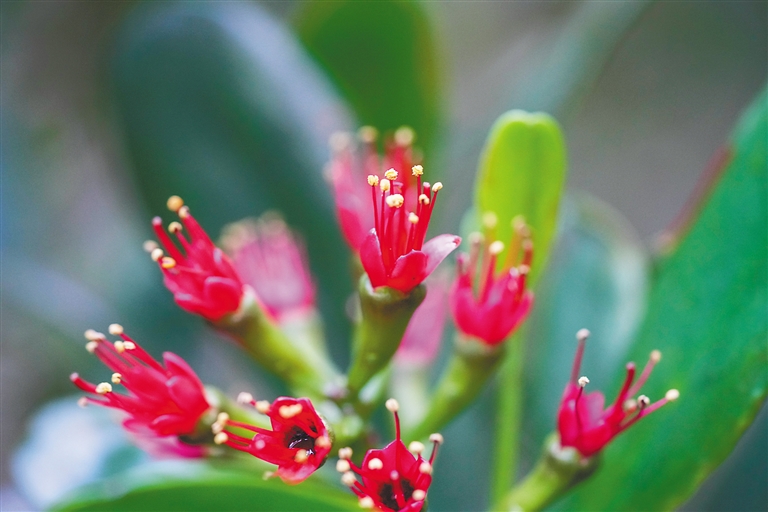
Photo taken on May 27 shows a Red-flowered Black Mangrove comes into bloom at Haikou Dongzhai Port National Nature Reserve. (Photo: Li Tianping/Hainan Daily)
However, the Red-flowered Black Mangrove's distribution in Hainan is extremely limited, and the species was once endangered.
In 2006, a research team carried out a systematic investigation and study into the distribution of Red-flowered Black Mangroves in China, and found a total of 349 wild plants, including nine plants at Sanya's Tielu Port and 340 plants at Xincun Port in Lingshui. Since then, further surveys have shown that the number of Red-flowered Black Mangroves at Tielu Port has remained unchanged, while the number at Xincun Port showed a sharp decline, with only two plants remaining as of 2018.
In April 2023, a survey by the Hainan Academy of Forestry found just twelve plants growing in the wild, including the nine plants growing at Tielu Port and three plants at Xincun Port.
Fortunately, purposeful cultivation and human-assisted recovery have ensured the survival and propagation of the Red-flowered Black Mangrove. Since the 1980s, Haikou Dongzhai Port National Nature Reserve has successfully introduced fourteen Red-flowered Black Mangrove plants from Lingshui. Sadly, they all succumbed to the abnormally frigid winter of 2008. In 2015, the Red-flowered Black Mangrove introduction and seedling cultivation work resumed, with more than 2,000 plants cultivated so far. In addition, the Hainan Academy of Forestry has also cultivated more than six hundred plants, which have been planted in Lingshui, Sanya, and other mangrove wetland areas.
China's mangroves account for just 0.14% of the world's total mangrove area but is home to around one-third of the world's known mangrove species, thus occupying a special position in the protection of mangrove plant diversity.
Hainan possesses the widest variety of mangrove species in China. Thirty-seven species of mangrove plants belonging to twenty individual families are native to China, and all of them can be found in Hainan. In addition to the Red-flowered Black Mangrove, there are also endangered species such as the Jack In A Box (Hernandia sonora), Mangrove Palm (Nypa fructicans), and Sagasa (Scyphiphora hydrophyllacea), all of which have been listed as wild plants under national key protection.
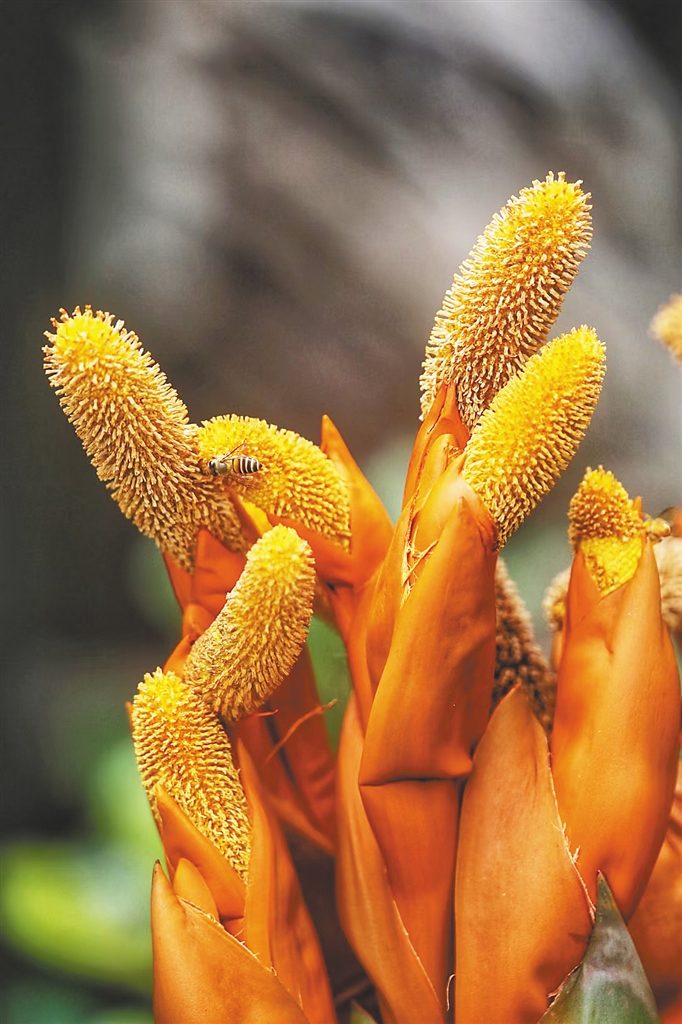
The flower of the endangered Mangrove Palm in Hainan. (Photo: Zhang Mengwen)
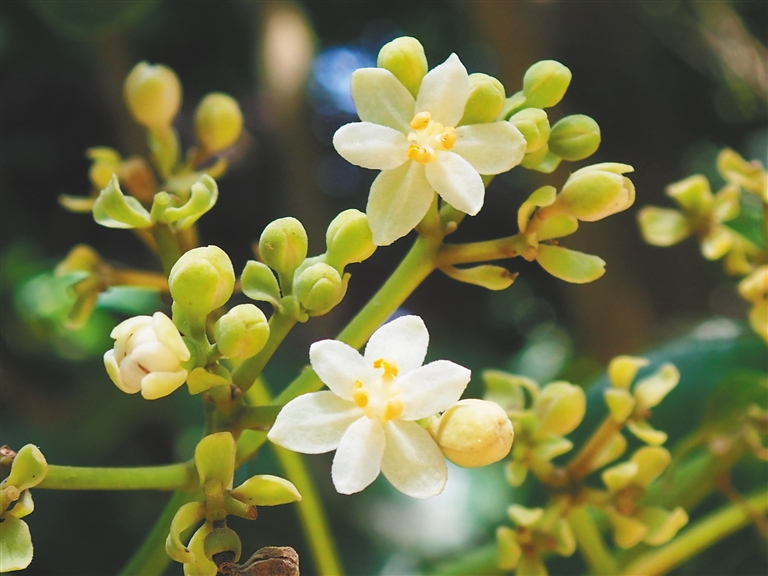
Endangered Jack In A Box. (Photo: Fang Zanshan)
Purifier, Windbreaker, and Breakwater
Wetlands are known as the "kidney of the earth", while mangroves are also known as the "green lungs of the ocean". So, how do mangrove wetlands combine the functions of both a "kidney" and a "lung"?
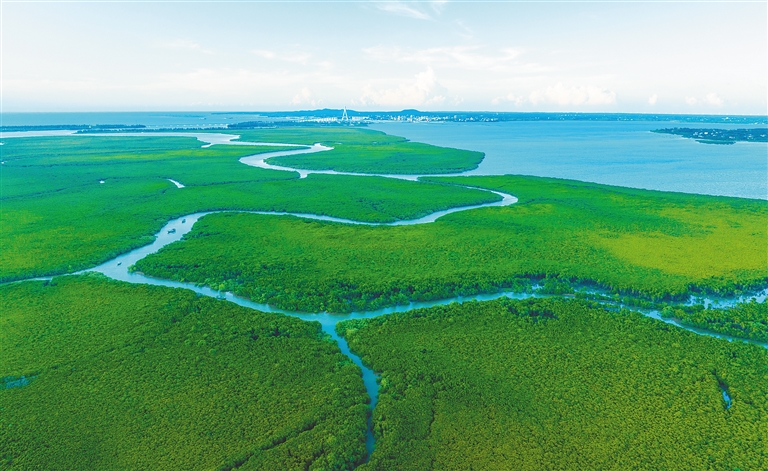
Once summer hits, the mangrove forests of Haikou Dongzhai Port National Nature Reserve become even lusher.
(Photo: Li Tianping/Hainan Daily)
Mangroves are marine forest communities composed of woody plants, which, like other plants, absorb a large amount of carbon dioxide through photosynthesis, converting it into organic carbon, and releasing a large amount of oxygen for human beings and various organisms to use in respiration. Scientific studies have shown that, per unit area, mangrove wetlands are about ten times more capable of sequestering carbon than tropical rainforests. By supplying oxygen and fixing nitrogen, mangrove wetlands thus function as a "lung".
But what about as a "kidney"? This is where the water purification and siltation promotion effects of the mangroves take center stage. The dense root systems of mangroves slow down the flow of seawater, increase sedimentation rates, and partially purify the water that flows through them. In addition, mangroves are also remarkably good at absorbing and accumulating nitrogen and phosphorus, effectively reducing the nitrogen and phosphorus content in aquaculture wastewater generated by coastal aquaculture, thereby reducing the risk of water eutrophication (an excess of nutrients). Mangroves also have their own way of locking heavy metals and organic pollutants into the sediment in which they grow, forming metal sulfides that, in turn, play a role in purifying seawater.
Raising land from the ocean and providing a habitat for all
Mangroves are known as the "pioneers of land creation". Their pillar roots, respiratory roots, surface roots, plate roots and other morphological root systems all contribute to the promotion of siltation. Their intricate root systems can hold on to various substances such as mud and sand, promoting the build-up of sediment which turns into land. The siltation rate of mangrove forests is two to three times higher than that of regular tidal flats.
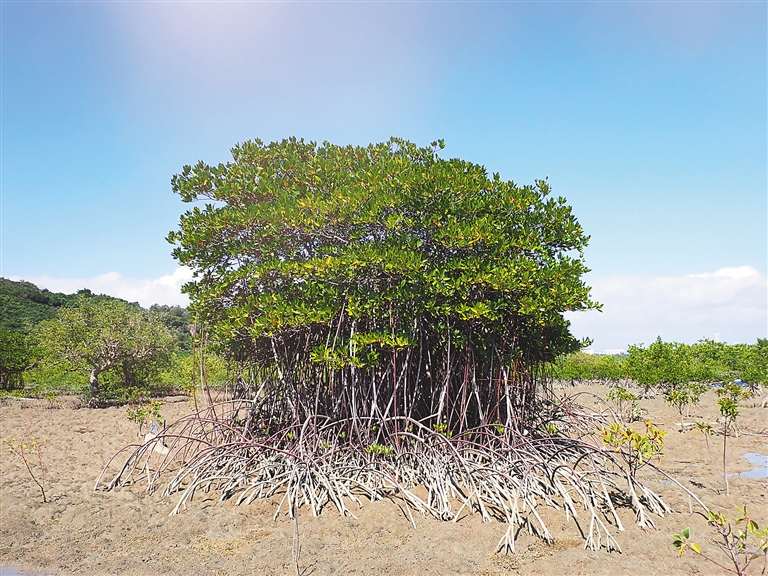
The tide at Tielu Port in Sanya recedes, revealing the mangroves' well-developed root system. (Photo: Fang Zanshan)
Mangroves are also natural farms and fish nurseries. Their extensive, dense root systems form a natural barrier, crisscrossing tidal gullies and shallow waters, providing an excellent haven for fish, shrimp, crabs, and shellfish.
The mangrove forests of Hainan boast breathtaking ecological diversity. According to partial statistics, 203 species of birds, twelve species of amphibians, twenty-three species of reptiles, twenty-one species of mammals, 165 species of fish, sixty-three species of crab, and seventy-seven species of mollusc can be found in Hainan's mangroves. As ecological surveys continue, these figures are set to increase.
今 日 要 闻
MORE关 注 我 们
